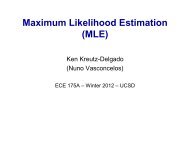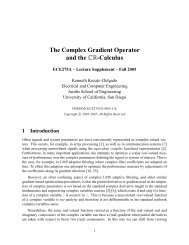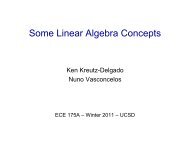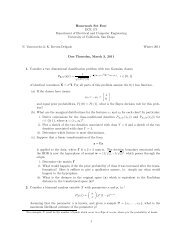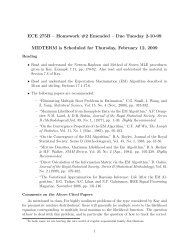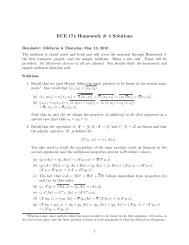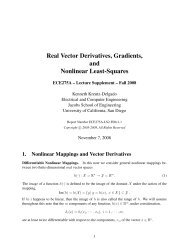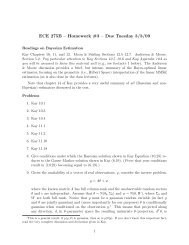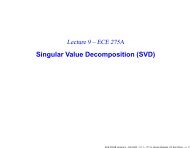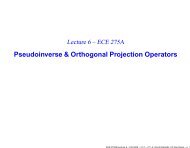ECE 275B – Homework #2 – Due Tuesday 1/30/07 - UCSD DSP Lab
ECE 275B – Homework #2 – Due Tuesday 1/30/07 - UCSD DSP Lab
ECE 275B – Homework #2 – Due Tuesday 1/30/07 - UCSD DSP Lab
Create successful ePaper yourself
Turn your PDF publications into a flip-book with our unique Google optimized e-Paper software.
<strong>ECE</strong> <strong>275B</strong> <strong>–</strong> <strong>Homework</strong> <strong>#2</strong> <strong>–</strong> <strong>Due</strong> <strong>Tuesday</strong> 1/<strong>30</strong>/<strong>07</strong><br />
Reading<br />
Kay Chapter 5; Moon Sections 10.5, 10.6, and 12.3.6. Make sure to understand every<br />
example. The key ideas are a) Sufficient Statistics (especially as a form of data compression<br />
and their importance for finding UMVUE’s); b) the Exponential Family of distributions<br />
(especially the relationship to sufficient statistics); and c) the Rao<strong>–</strong>Blackwell<strong>–</strong>Lehmann<strong>–</strong><br />
Scheffe (RBLS) Theorem as a procedure for finding UMVUE’s. 1<br />
Also read the excerpt from Steven Pinker’s book How the Mind Works (Norton, 1997) on<br />
the distinction between the frequentist and subjective interpretations of probability, which<br />
I have placed on the class website.<br />
Problems<br />
1. Let x = (x1, ··· ,xn) T be a vector of continuous iid samples. The order statistics<br />
x ′ = (x ′ 1, ··· ,x ′ n) T = T (x) are defined to be the increasing rearrangement of the<br />
elements of x,<br />
x ′ 1 ≤ x ′ 2 ≤···≤x ′ n<br />
for x ′ 1, ··· ,x ′ n an appropriate permutation of the elements of x. Because xi are assumed<br />
to be independent realizations of a continuous random variable one can assume that<br />
almost surely (i.e., with probability 1),<br />
x ′ 1
A statistic g (not necessarily sufficient) is said to be necessary if the partition it induces<br />
is coarser than the partition induced by any sufficient statistic. Equivalently, g is<br />
necessary iff g is a measurable function of any particular sufficient statistic T , g = f(T ),<br />
for some g and T dependent measurable function f.<br />
With the above definitions of sufficiency and minimality, a minimal sufficient statistic<br />
can then be defined to be a necessary and sufficient statistic.<br />
Consider a statistic which induces a partition (equivalence class) on X via<br />
x ∼ x ′<br />
iff<br />
pθ(x)<br />
pθ(x ′ ) = g(x, x′ ) = function of x and x ′ independent of θ.<br />
Prove that this statistic is necessary and sufficient and hence is a minimal sufficient<br />
statistic. 3<br />
3. Consider the pdf’s or pmf’s listed in problems 5.1, 5.2, 5.3, and 5.14 of Kay and in<br />
10.6-12 of Moon. Place all of them into scalar exponential family form and for each<br />
one give a sufficient statistic.<br />
4. For a k<strong>–</strong>parameter exponential family distribution, show that if the elements of the<br />
vector of sufficient statistics are affinely dependent (i.e., are not linearly independent<br />
in the affine sense) then the order of the distribution can be reduced below k, showing<br />
that the original vector of sufficient statistics is not minimal. Similarly, if the vector<br />
of natural parameters as functions of the parameter vector θ are affinely dependent,<br />
again show that the order of the distribution can be reduced. This is consistent with<br />
the claim made in class that the k<strong>–</strong>dimensional vector of sufficient statistics for a kparameter<br />
exponential family distribution is minimal iff the two affine independence<br />
conditions are met.<br />
5. Let y and x be jointly random vectors. For notational convenience, define the quantities<br />
〈y〉 E {y} and y E {y| x}, and note that 〈y〉 = 〈y〉. 4 Prove that the covariance<br />
matrices for y and y satisfy the relationship<br />
Cov {y} =Cov{E {y| x}} +E{Cov {y| x}} =Cov{y} +E{Cov {y| x}} ,<br />
which, in particular, implies the important fact that<br />
Cov {y} ≥Cov {y} .<br />
This fact shows that the conditional mean random variable y = E{y | x} is more<br />
tightly distributed around its mean than y. Thus the processing of a measurement<br />
x to form the conditional mean y will generally result in less uncertainty about an<br />
3 This proof is essentially done in lecture, so this problem is basically an assignment in directed reading.<br />
4 I.e., y is an unbiased estimator of y.<br />
2
unknown random variable y, provided that x and y are not independent. Later, we<br />
will see that the conditional mean provides an optimal reduction of the uncertainty in<br />
y in the matrix mean-squared error sense.<br />
6. Let the real scalar random variable y be uniformly distributed over the closed interval<br />
[0, θ], for unknown θ, 0
Show that the minimal sufficient statistic derived in the previous problem can be<br />
updated recursively as<br />
T (yk) =T (yk−1)+bk y[k]<br />
and give the functional form of bk. Also give the dimensions of T (yk) andbk, noting<br />
that the minimal sufficient statistic T (yk) and the “gain” bk are constant in dimension<br />
and do not increase in size as k increases.<br />
4



